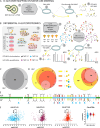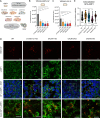Targeting host O-linked glycan biosynthesis affects Ebola virus replication efficiency and reveals differential GalNAc-T acceptor site preferences on the Ebola virus glycoprotein
- PMID: 38757972
- PMCID: PMC11237518
- DOI: 10.1128/jvi.00524-24
Targeting host O-linked glycan biosynthesis affects Ebola virus replication efficiency and reveals differential GalNAc-T acceptor site preferences on the Ebola virus glycoprotein
Abstract
Ebola virus glycoprotein (EBOV GP) is one of the most heavily O-glycosylated viral glycoproteins, yet we still lack a fundamental understanding of the structure of its large O-glycosylated mucin-like domain and to what degree the host O-glycosylation capacity influences EBOV replication. Using tandem mass spectrometry, we identified 47 O-glycosites on EBOV GP and found similar glycosylation signatures on virus-like particle- and cell lysate-derived GP. Furthermore, we performed quantitative differential O-glycoproteomics on proteins produced in wild-type HEK293 cells and cell lines ablated for the three key initiators of O-linked glycosylation, GalNAc-T1, -T2, and -T3. The data show that 12 out of the 47 O-glycosylated sites were regulated, predominantly by GalNAc-T1. Using the glycoengineered cell lines for authentic EBOV propagation, we demonstrate the importance of O-linked glycan initiation and elongation for the production of viral particles and the titers of progeny virus. The mapped O-glycan positions and structures allowed to generate molecular dynamics simulations probing the largely unknown spatial arrangements of the mucin-like domain. The data highlight targeting GALNT1 or C1GALT1C1 as a possible way to modulate O-glycan density on EBOV GP for novel vaccine designs and tailored intervention approaches.IMPORTANCEEbola virus glycoprotein acquires its extensive glycan shield in the host cell, where it is decorated with N-linked glycans and mucin-type O-linked glycans. The latter is initiated by a family of polypeptide GalNAc-transferases that have different preferences for optimal peptide substrates resulting in a spectrum of both very selective and redundant substrates for each isoform. In this work, we map the exact locations of O-glycans on Ebola virus glycoprotein and identify subsets of sites preferentially initiated by one of the three key isoforms of GalNAc-Ts, demonstrating that each enzyme contributes to the glycan shield integrity. We further show that altering host O-glycosylation capacity has detrimental effects on Ebola virus replication, with both isoform-specific initiation and elongation playing a role. The combined structural and functional data highlight glycoengineered cell lines as useful tools for investigating molecular mechanisms imposed by specific glycans and for steering the immune responses in future vaccine designs.
Keywords: Ebola virus; GalNAc-T; O-glycosylation; glycosyltransferase; mass spectrometry; mucin-like domain; post-translational modification; tandem mass tag; viral glycoprotein.
Conflict of interest statement
H.H.W. owns stocks in and is a consultant for and co-founder of EbuMab, ApS, Hemab, ApS, and GO-Therapeutics Inc. All other authors declare no conflicts of interest.
Figures






Similar articles
-
Site-specific glycosylation of Ebola virus glycoprotein by human polypeptide GalNAc-transferase 1 induces cell adhesion defects.J Biol Chem. 2018 Dec 21;293(51):19866-19873. doi: 10.1074/jbc.RA118.005375. Epub 2018 Nov 2. J Biol Chem. 2018. PMID: 30389789 Free PMC article.
-
Comprehensive functional analysis of N-linked glycans on Ebola virus GP1.mBio. 2014 Jan 28;5(1):e00862-13. doi: 10.1128/mBio.00862-13. mBio. 2014. PMID: 24473128 Free PMC article.
-
N-Glycans Mediate the Ebola Virus-GP1 Shielding of Ligands to Immune Receptors and Immune Evasion.Front Cell Infect Microbiol. 2020 Mar 6;10:48. doi: 10.3389/fcimb.2020.00048. eCollection 2020. Front Cell Infect Microbiol. 2020. PMID: 32211339 Free PMC article.
-
Myriad mechanisms: factors regulating the synthesis of aberrant mucin-type O-glycosylation found on cancer cells.Glycobiology. 2025 Apr 23;35(6):cwaf023. doi: 10.1093/glycob/cwaf023. Glycobiology. 2025. PMID: 40247681 Review.
-
Site-specific protein O-glycosylation modulates proprotein processing - deciphering specific functions of the large polypeptide GalNAc-transferase gene family.Biochim Biophys Acta. 2012 Dec;1820(12):2079-94. doi: 10.1016/j.bbagen.2012.09.014. Epub 2012 Sep 26. Biochim Biophys Acta. 2012. PMID: 23022508 Review.
References
-
- Bornholdt ZA, Turner HL, Murin CD, Li W, Sok D, Souders CA, Piper AE, Goff A, Shamblin JD, Wollen SE, Sprague TR, Fusco ML, Pommert KBJ, Cavacini LA, Smith HL, Klempner M, Reimann KA, Krauland E, Gerngross TU, Wittrup KD, Saphire EO, Burton DR, Glass PJ, Ward AB, Walker LM. 2016. Isolation of potent neutralizing antibodies from a survivor of the 2014 Ebola virus outbreak. Science 351:1078–1083. doi:10.1126/science.aad5788 - DOI - PMC - PubMed
-
- Gilchuk P, Murin CD, Milligan JC, Cross RW, Mire CE, Ilinykh PA, Huang K, Kuzmina N, Altman PX, Hui S, et al. . 2020. Analysis of a therapeutic antibody cocktail reveals determinants for cooperative and broad Ebolavirus neutralization. Immunity 52:388–403. doi:10.1016/j.immuni.2020.01.001 - DOI - PMC - PubMed
MeSH terms
Substances
Grants and funding
LinkOut - more resources
Full Text Sources
Medical

